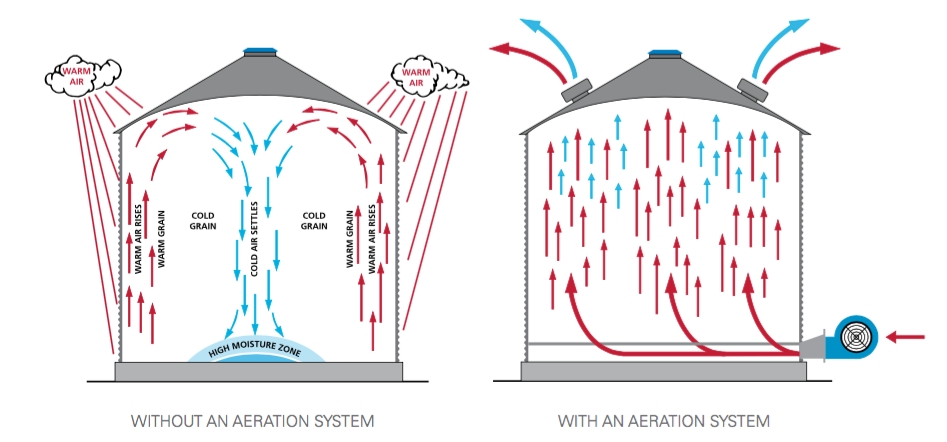Why is Temperature so Important?

Welcome back to yet another entry on grain storage conditions.
What makes grain and silo temperature so imperative to the vitality of your grain? To put it briefly, pretty much all bad things can fester in warmer temperatures; from pests to mould, to fungi, we’ve seen it all.
Did you know that the germination of your grain is impacted if it reaches a certain temperature? Being stored between 40-55⁰C, individual seeds will dry excessively, resulting in damaged proteins and nutrients. Luckily though, there are a few simple things you can do to lower the temperature of your grain and decrease your risks.
Pests will are one of your biggest problems, however they also happen to be one of the easiest to prevent. Effective grain hygiene and aeration cooling can overcome your pest problems by 85% With an internal silo temperature of 30-40⁰C , insects can breed and grow at astronomical rates. Within a matter of weeks, your entire supply can be contaminated, and while fumigation can stop the problem, it can’t repair the damage that has already been done. The good news however, is that between 15-20⁰C degrees, the most common Australian pests (depending on the variety) will completely stop breeding. Thus, having your grain at the ideal temperature from the get-go will prevent any infestation before it can even begin.

A hot spot is described as a localised high temperature zone found in stored grain. These hot spots can occur anywhere within your silo, usually caused by an infestation that produces excessive CO2(Carbon Dioxide) gas. As I’ve already mentioned, these infestations can be avoided to begin with, however sometimes things just don’t go to plan. Grain is quite a poor heat conductor, making it difficult to detect these hot spots within your storage from an external point of view. Thermal imaging is one method used to detect hot spots. This non-contact method involves installing several sensors within the silo that will detect high temperate readings once reaching a certain point. Another option is a CO2 Sniffer. HE Silos Forbes has been working with an innovative company from Denmark , producing a state-of-the-art sensor. This system is inserted through the lid of your silo, using brackets to hold the sensor from the roof of the silo and centrally located within your grain. With the ability to detect any issues within the first 24-48 hours of infestation, it sure is a beauty of a system.
The other kicker when it comes to high heat? Is Condensation! The impact moisture has on-stored grain is huge. The higher the moisture and temperature inside a silo, the greater risk of rapid pest reproduction, mould growth and fungi development. It will ultimately cause the quality of your grain to deteriorate. One of the worst things about condensation is once it starts, there’s no real way to remove it. While your grain will always have some moisture in it, putting your grain into storage at too high of a moisture content will greatly increase the risk of condensation, the breeding ground for mould. Sometimes things out of your control do happen and grain needs to be stored earlier than planned. In these circumstances, having an aeration system in place can be your lifeline. Another very important thing to note is that your silo should only be sealed while fumigating, this will aid in avoiding condensation build up.
There has always been a lot of confusion surrounding aeration cooling and aeration drying. After all how could they be so different? To cool your grain, a relatively small airflow rate is needed. About 2-4 litres of air per second, per tonne. Whereas drying grain needs a far higher air flow rate, upwards of 15 litres of air per second, per tonne. Cooling grain, even by just 10⁰, greatly reduces the risk of infestations and mould issues. By following the recommended storage temperature of 15-20⁰C, you can stop the risk all together. Grain needs to be harvested in quite a tight window to avoid too much moisture being left in the seed, or too little as to cause damage to germination. The ideal moisture content to harvest is anywhere below 20%, however around the 12.5% mark is what is most widely recommended (different grains have different moisture benchmarks). For on farm storage, any grain over 12.5%MC needs to be stored with an aeration system in place. Failure to do so is asking for issues down the track.

Well folks, I hope that gives you an understanding of just how important temperature is when it comes to grain storage. From pests to mould, to fungi, high temperature is where many bad things can fester.
The team at HE Silos can assist with any questions you may have regarding Aeration Systems, whether it be retrofitting to your already owned silo or pondering the investment of grain storage in the future.
You’ll hear from me in a few short weeks!

Steve, The Silologist™

